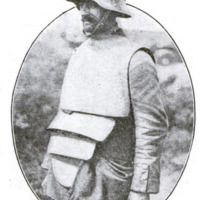Armor for the Shock Troops of the Modern Army
Contenuto
-
Titolo
-
Armor for the Shock Troops of the Modern Army
-
Article Title and/or Image Caption
-
Armor for the Shock Troops of the Modern Army
-
extracted text
-
THE German army has provided armor for snipers, sentries and observers, the suit being designed chiefly for soldiers whose duties are stationary. The metal helmet is common to both the Allied and German armies. A cuirass invented by Oscar Schaumann, a German, in 1908, attracted considerable attention. It has three plates, the first being of extremely hard steel and designed to break the points of the projectiles striking it. The second plate is composed of aluminum or duraluminum and the third of celluloid or horn. Another substance, such as silk or asbestos, may be interposed between the plates and thecuirass proper to lessen the force of the bullets. The first plate, however, is designed to take away the momentum of the projectiles so that when they strike the cuirass proper it will be only slightly dented. Tests of the cuirass proved satisfactory. A portable buckle fashioned after the ideas embodied in this cuirass is described as being studied by the Prussian Department of Artillery Technology. A plate of hard steel riveted to a plate of duraluminum constitutes the principal feature of the shield. Two leather bracelets fastened to the left forearm enable the infantryman to carry the shield. It does not interfere with the movements of the soldier and has considerable protective value. Reports of battles in Europe have not revealed the use of this buckler, however, this being due to the fact that all the available supply of duraluminum in Germany was needed for the building of Zeppelins. 1T has been pointed out that the buckler could be employed to great advantage in throwing bombs because it enables the soldier to have the free use of his hands. The steel helmet worn by the soldiers in the European war has demonstrated its protective value unmistakably. Records of battles since September, 1915, show that it saved the lives of many men. The helmet does not always stop bullets, but even when it is pierced it weakens the projectile’s force so as to prevent serious injury.
-
Autore secondario
-
Oscar Schaumann (inventor)
-
Lingua
-
eng
-
Data di rilascio
-
1918-08
-
pagine
-
247
-
Diritti
-
Public Domain (Google digitized)
-
Archived by
-
Filippo Valle
-
Alberto Bordignon (Supervisor)
 1.png
1.png